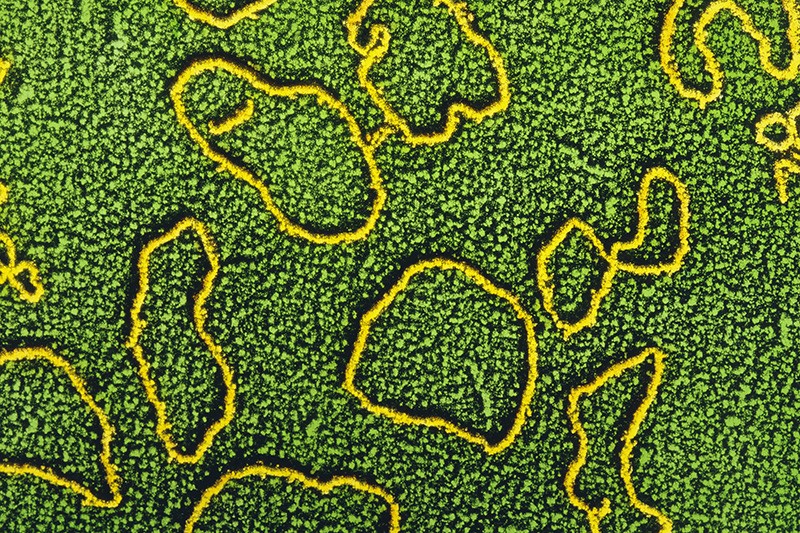Circular molecules of DNA, called plasmids, have been transformed into systems that can record cellular data.Credit: Gopal Murti/SPL
Researchers have harnessed the popular gene-editing tool CRISPR–Cas9 to turn DNA into a sensitive recording device that can document the duration and order of events within cells — and even erase and re-record information in the same genome.
The work, published in Science on 15 February1, joins a flock of other CRISPR-based cellular recorders that have emerged from research labs over the past few years. The hope is that such recorders could keep track of changes in gene expression, trace a cell’s individual family lineage or monitor shifts in environmental conditions.
“It’s clear that the genome has this enormous recording capacity,” says Jan Philipp Junker, a systems biologist at the Max Delbrück Center for Molecular Medicine in Berlin. “With CRISPR, we finally have the tools to use it.”
It is one of many ways in which researchers are tinkering with the machinery of CRISPR–Cas9 to forge new types of molecular tools. Two papers also published today in Science describe how CRISPR can be used to detect disease-causing viruses2,3.
The inspiration for the cellular recorders was the flight-data recorder found in many planes, says chemical biologist David Liu of the Broad Institute of MIT and Harvard in Cambridge, Massachusetts. “Just like a flight-data recorder records events that happen to an airplane, the cell-data recorders can be used to monitor stimuli that the cell is exposed to, or changes in the cell signalling,” he says.
Slice and dice
Researchers typically use CRISPR–Cas9 to alter DNA sequences by directing the Cas9 enzyme to cut DNA at a site dictated by the sequence of a short fragment of RNA, called a guide RNA. In many organisms, these DNA breaks are then repaired by the cell in ways that can alter the original DNA sequence.
Liu and his colleague, chemist Weixin Tang, also at the Broad Institute, took advantage of Cas9’s DNA-slicing ability to engineer a cellular recorder using circular molecules of DNA called plasmids. Plasmids replicate inside bacterial cells, sometimes producing hundreds of copies in a single cell.
Liu and Tang altered three DNA letters in one such plasmid, so that it contained a sequence targeted by a guide RNA. They also engineered the bacterium to express Cas9 only in the presence of a particular antibiotic, and dubbed the whole system CAMERA1.
Bacteria lack some of the DNA-repair mechanisms used by mammalian cells to fix the damage wrought by Cas9 — instead, when the plasmid is targeted by Cas9, it is degraded. Another plasmid then replicates to take the place of the lost one.
Liu and Tang put both the altered and normal plasmids into cells and measured the relative ratio of the two. The proportion of altered plasmid fell in cells that had been treated with antibiotic, because the cells had begun to degrade the altered plasmids.
The result was an unusually sensitive recorder: Liu and Tang could read out information from as few as ten bacterial cells. The magnitude of the change reflected the amount of antibiotic present, andthe duration of exposure. Liu and Tang also developed methods for resetting the ratio of altered to unaltered plasmid, erasing the first recording and readying the cell to document the next event using the same set of plasmids.
Keeping watch
They then moved on to create more recorders. One, called CAMERA2, relies on modified CRISPR systems called ‘base editors’, developed by Liu’s lab4 in 2016, that can alter single DNA letters without breaking both strands of the genome. Liu and Tang used CAMERA2 to record up to four different stimuli in bacterial cells, including exposure to light and viruses, and the order in which they occurred.
The researchers also modified CAMERA2 to work in mammalian cells, recording changes directly in the genome rather than in plasmids. Tang and her colleagues hope to use the system to answer questions about how cells take on specific identities.
The CAMERA recorders will join a host of other cellular recorders under development. Synthetic biologist Harris Wang of Columbia University Medical Center in New York City has been developing systems that he hopes to use to study microbes in the gut5.
And Junker’s lab is working on a recorder that he aims to use to trace the developmental pathway of individual cells in zebrafish. He first thought of the approach a little over two years ago, he says. “I thought this was an exotic idea that I had,” says Junker. “And suddenly everybody is doing it.”
Nature 554, 414-415 (2018)

